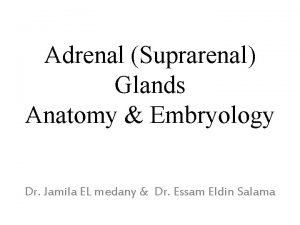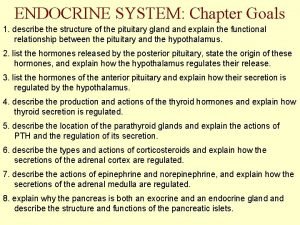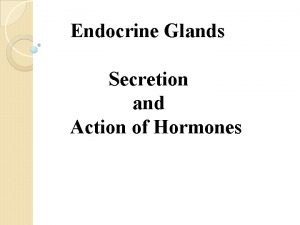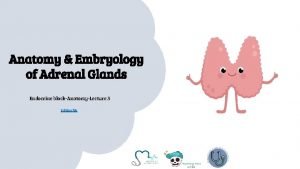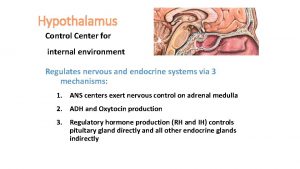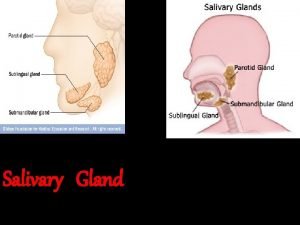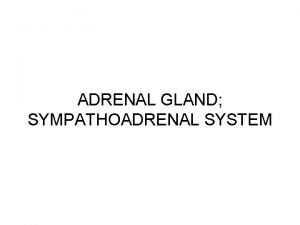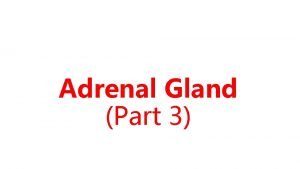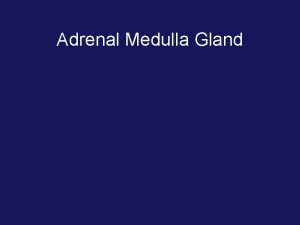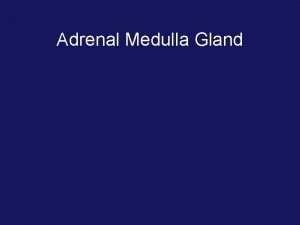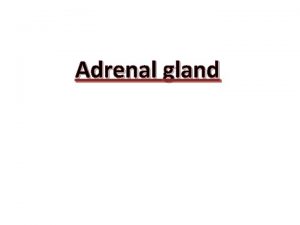Structure and functions of Adrenal gland Each adrenal















- Slides: 15

Structure and functions of Adrenal gland

• Each adrenal or suprarenal gland in man weight about 6 grams, measures 25 to 50 mm in length, and lies at the top of each kidney. • The adrenal glands are somewhat pyramidal in shape and have a rich blood supply. • They are innervated by the sympathetic nervous system, and consist of two parts that are embryologically, anatomically and functionally different. • In the typical mammal, each gland consists of an external reddish brown cortex which surrounds an internal grayish medulla.

• The cortex is made up of three zones, the cells of which differ in form and function. • The outermost zona glomerulosa (ZG) • The thick, middle zona fasciculata (ZF) • The third or the innermost zone is the zona reticularis (ZR)


• Hormones of the Adrenal Cortex • The adrenal cortex is absolutely essential to life. When it is completely removed most animals will not live more than a week or so. • The cortex has several hormones and it ranks next to the adenohypophysis in endocrine importance. • Secretion of the cortical hormones is under the control of ACTH from the pituitary. • All the adrenocortical hormones are steroid compounds and can be divided into three groups.

• Glucocorticoids such as cortisone, hydrocortisone (cortisol), and corticosterone. • (ii) Mineralocorticoids such as aldosterone and deoxycorticosterone. • (iii)Androgens sex hormones which have chiefly androgenic and to minor extent estrogenic effects.

• Functions of the Adrenocortical Hormones: • 1. Effect on carbohydrate and protein metabolism: • The glucocorticoid hormones exert their influence primarily on carbohydrate metabolism. • They increase the blood glucose level. Enhance the conversion of protein (and fat) to carbohydrates. • Cortisol also affects fat metabolism.

• 2. Effect on mineral, salt, and water Metabolism: The mineral corticoids have a regulatory effect on the relative concentrations of mineral ions (especially sodium and potassium) in the body fluids, and therefore on the water contents of the tissues. • The insufficiency of the mineral corticoids results in an increased excretion into the urine of sodium ions, chloride ions, and water, accompanied by a fall in blood sodium chloride, and bicarbonate. • The administration of the mineral corticoid hormones has the opposite effects, resulting in an increase in blood sodium and chloride concentrations, more retention of water by the body, a decrease in potassium concentration, and a restoration of p. H of the blood to its more normally alkaline level. •

• 3. Effect on sexual development: • Under certain circumstances the adrenal cortex appears to secrete steroids which are similar in their effects to male hormones. • For example, adrenal cortical tumours in females may give rise to masculine characters, such as beard and deep voice, etc. • Although the female sex hormones have also been detected in cortical extract, it is believed that they are simply intermediates in the formation of other adrenocorticosterioids.

• 4. Anti-allergy, anti-inflammatory and other effects: • Several of the cortical hormones (e. g. , cortisol and cortisone) have a marked influence in preventing the appearance of an inflammation. • They are also used to control the symptoms of particular arthritic conditions and rheumatic fever. • The steroid secretions of the adrenal cortex also exercise several other influences on the body functions including a role in decreasing the level or red and white blood cells and stimulating the secretions of the digestive tract.

• Hypoadrenalism : • Insufficiency of the cortical hormones results in Addison’s disease. • In this disease the adrenal cortex degenerates, resulting in a number of symptoms, including a characteristic bronzing of the skin, muscular weakness, low blood pressure, and digestive disturbance. • The sufferers of this disease are cured by a proper administration of cortical hormones from some external source.

• Hyperadrenalism : • Hyperfunction or over secretion by the adrenal cortex as a result of excessive secretion of ACTH, gives rise to Cushing’s disease. • The symptoms include high blood pressure, salt retention, swelling of the tissues with water, demineralization of the bones, and loss of sexual function. • . Treatment in Cushing’s disease consists of removing an adrenal tumor if this is the cause, or decreasing the secretion of ACTH. if possible.

• Hormones of the Adrenal Medulla: • The adrenal medulla in man consists of two distinct types of cells. • These are adrenaline-secreting cells and the noradrenaline-secreting cells which are responsible for the production of the two hormones, adrenaline or epinephrine and norepinephrine or noradrenaline respectively.

• Adrenaline functions as the so-called “emergency” hormone for the body because the general secretion of this hormone centers around emergency functions of the body such as those of fear, fight, and anger, etc. • During emotional states epinephrine (adrenaline) is secreted in great amounts. It has a decided effect in elevating the glucose level in the bloodstream by somehow enhancing enzymatic conversion of liver glycogen to glucose. • The rise in blood glucose is accompanied by an increase in oxygen consumption, body temperature and heat production.

• Together, most or all these effects are sometimes called the alarm reaction. • If the action of adrenaline is somehow inhibited, a vertebrate cannot adjust rapidly to emergencies. • Noradrenaline (Norepinephrine): • This hormone of the adrenal medulla has somewhat similar effects. • It raises the blood pressure, but it is responsible for constriction instead of dilation of the blood vessels. • Noradrenaline is a chemical transmitter at sympathetic nerve endings and in the central nervous system, but is also present in the adrenal medulla, both as a hormone and also as precursor of adrenaline.
 Visceral nervous system
Visceral nervous system Relation of adrenal gland
Relation of adrenal gland Summary of adrenal gland
Summary of adrenal gland Ectocrine
Ectocrine Acth
Acth Adrenal gland regions
Adrenal gland regions Female cat dissection
Female cat dissection Betoderm
Betoderm Acth stimulation test
Acth stimulation test Adrenal gland hormones
Adrenal gland hormones Adrenal gland
Adrenal gland Adrenal gland epithelium
Adrenal gland epithelium Neural plate
Neural plate Pituitary gland and pineal gland spiritual
Pituitary gland and pineal gland spiritual Pineal gland pituitary gland
Pineal gland pituitary gland Embryonic development of pituitary gland
Embryonic development of pituitary gland

